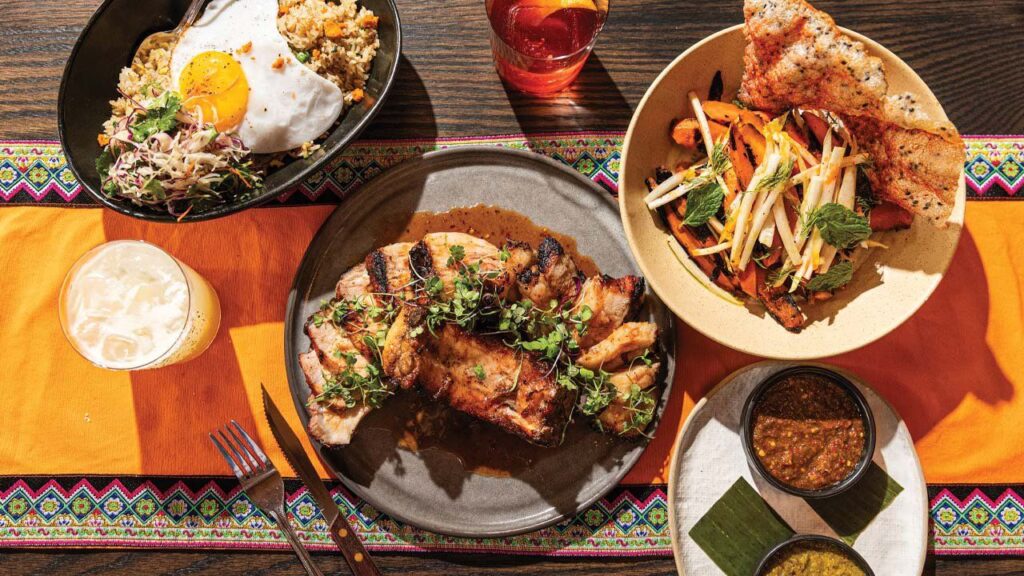We’ve spent the last 12 months sleeping, eating, and sailing our way around the globe in order to bring you the 29th edition of the Hot List, our carefully curated annual collection of the best new (and reborn) hotels, restaurants, and cruise ships in the world, and we had a ton of fun doing it. How could we not when it involved activities like zip-lining to dinner in the Maldives, sleeping in an actual tree house in Kenya, and eating a truly memorable meal in a converted auto body shop in Mexico City? The through line of this year’s list is joy—something we could all use a little more of in our lives. These are the 2025 Hot List winners.
Click here to see the entire Hot List for 2025.
Tucked away on rue Saint-Roch in Paris’s 1st arrondissement is chef Pierre Touitou’s latest and most personal project. It’s distinctly French, yet far from your average bistro fare. This is a sleek restaurant from a forward-thinking young chef with all the classic training (under such chefs as Alain Ducasse) but also one who is well-traveled and constantly in dialogue with his peers around the world. Touitou seems eager to push the boundaries of what French food can be. The menu bears influence from the chef’s trips to places like Japan and also his Mediterranean heritage: On my visit, there were ingredients like yuzu koshō, miso, and dashi, but also plenty of butter, sabayon (that sweet, foamy egg-white sauce), and seasonal French produce. The menu changes daily; it has included the likes of rich endive tarte topped with frisée lettuce and a truffle vinaigrette; braised beef with savoy cabbage, candied oranges, and almonds; and an iconic île flottante with smoked pepper and sesame praline for dessert. Don’t miss the wine list, which is filled with natural offerings that will satisfy the more adventurous while also pleasing those with a conventional palate. —Kyle Beechey
Acamaya — New Orleans
If you’re unfamiliar with chef Ana Castro, that won’t very last long—her star is ascending, and rapidly. Born in Texas and raised in Mexico City, she now calls New Orleans home. NOLA is where she began Acamaya, her modern Mexican restaurant in the Bywater. It’s here in the dimly lit yet high-energy space where Castro cleverly combines the best of both worlds: the mariscos dishes she grew up eating, now made with local seafood plucked from the waters of Louisiana’s Gulf Coast. Think zippy shrimp aguachile; thick yellow discs of masa crowned with plump lump crab; and flaky fish that has been butterflied and grilled until crispy-skinned and is swimming in a pool of creamy spicy salsa—served with a side of fresh-made tortillas so you can assemble all the DIY tacos your heart (and stomach) desires. Castro’s passion is infectious and her cooking, soulful—she’ll be a household name before you know it. —Omar Mamoon
The November-opened AngloThai in Marylebone is a beacon of warmth, even on London’s grayest days. Perhaps that’s because it’s the passion project of husband and wife duo John and Desiree Chantarasak, who bring together Thai recipes and distinctly British ingredients on a menu driven by seasonal produce. On my visit, the crab bisque amuse-bouche whet the whistle (and was a thoughtful example of waste reduction, as it was made with remnants of crab featured in another dish). Then the freshest Irish oysters, drizzled in a slap-in-the-face-hot fermented chili sauce, arrived before pillowy cuttlefish buns and a punchy stream trout crudo that stole the show. For the main we enjoyed pollock fish balls in a sour orange curry sauce and a glistening and succulent pork chop. With a menu as bright and flavorful as this, saving room for dessert may sound like a challenge, but the cacao ganache proved the reward was well worth the effort. The wine list, meanwhile, is not to be slept on: It’s an extensive showcase of British and European wines, ranging from the traditional to trendy skin-contact showstoppers. This is delicious escapism at its best, cooked with lots of love. —Lucy Bruton
Arami — La Paz, Bolivia
Marsia Taha’s deep exploration of Bolivia’s native ingredients and flavors has not only earned her widespread recognition—she was named Latin America’s best female chef in 2024 by World’s 50 Best—but also firmly placed her home country on the global gastronomic map. After leading the kitchen at the acclaimed Gustu, the La Paz restaurant created by Noma cofounder Claus Meyer, Taha has now launched her own independent project, Arami, in an elegant townhouse in the affluent Achumani neighborhood. Reflecting years of research and travel across Bolivia, her tasting menu offers dishes like alligator with payuje (a banana paste), grilled piranha with coconut and chives, and corvina paired with Amazonian nut milk and ají de gusanito—a sweet chili pepper named for its resemblance to white worms (don’t let that put you off, though). The space will soon expand to include a wine bar on the upper floor, showcasing lesser known yet exceptional Bolivian wines (also featured in the restaurant’s pairings), all sourced from the country’s high-altitude vineyards. —Rafael Tonon
After establishing Cuia, a lively café in São Paulo’s iconic Copan building, chef Bel Coelho returns to the city’s dining scene with Clandestina. It’s an equally thoughtful, more casual evolution of her acclaimed Clandestino, which was a series of immersive pop-ups that explored native Brazilian ingredients and culinary traditions. Now in a permanent space in Vila Madalena, she embraces a relaxed à la carte format in an intimate, low-lit setting. The menu continues her commitment to lesser-known local ingredients, featuring dishes such as beef crudo with Yanomami mushrooms—harvested by an Indigenous community in the Amazon—and duck gyoza with tucupi, a fermented manioc sauce central to Northern Brazilian cooking. —Rafael Tonon
Clara — Quito, Ecuador
When Clara opened, the goal was simple: to create a laidback, intentional bistro where diners could enjoy well-executed food, inventive cocktails, and a carefully curated wine list at fair prices. Located in the former El Pobre Diablo building (once home to a beloved bar that hosted cultural events for nearly three decades) in Quito’s La Floresta neighborhood, Clara preserves that welcoming, everyday feel while sharpening its focus on cuisine. The restaurant is led by an international trio of chefs—Spanish, Portuguese Venezuelan, and Ecuadorian—who apply their techniques to local ingredients, creating dishes that feel both refined and approachable, with a touch of nostalgia. A nose-to-tail philosophy runs through the menu, with highlights like a buttery brain sandwich (believe it) on house-made brioche with criolla tartar sauce, and a crispy pig ear salad with heirloom tomatoes, a nod to cevichocho, Ecuador’s traditional bean ceviche often sold as street food. Service is relaxed yet precise, with a knowledgeable team guiding guests through cocktails and wines. —Rafael Tonon
Pioneering “scale-to-tail” restaurant Saint Peter—by Australia’s most celebrated chef, Josh Niland, and his wife, Julie—is back in a 2.0 version as it opens in a brand-new space: the iconic Grand National Hotel in Paddington. This is where the who’s who of Sydney are keen to dine right now. A winner of three hats (Australia’s equivalent of the Michelin star), the highly awarded restaurant is a stone’s throw from its former home, this time with refined interiors presenting iconic Australian artworks by Ken Done and Olsen Gallery and custom tableware (by artisans Sam Gordon and Claudia Lau). Over lunch, dinner, and a 10-course chef’s table experience, the seafood is grilled, dry-aged, and everything in between. The new scaled-up restaurant comes complete with a bar and a 14-bedroom luxury boutique hotel where diners can experience the full extent of the Nilands’ vision. In rooms, find fish-fat soap and fish-bone ceramics amongst interiors handpicked by the Nilands together with Studio Aquilo. With traceability at its core, straight from sea to store, Niland’s whole-fish cooking remains a trailblazer worldwide, and the new outpost of Saint Peter is proof. —Monique Kawecki
Banng — Dehli NCR, India
Big Bangkok energy has arrived in Gurugram, India, at this vibey new crimson-red hot spot. The restaurant is famous on Instagram for its now viral tom kha pani puri, a bold take on Indian chaat that swaps tamarind chutney and spiced cumin water for chilled coconut broth with white oyster mushrooms and herbs. It comes served in a delicate porcelain elephant, reminiscent of the ceramics at Bangkok’s Chatuchak market. This dish is perhaps the best metaphor for the coming together of Mumbai insider turned Bangkok local Garima Arora (of Michelin-starred GAA fame in Bangkok) and Riyaaz Amlani, one of India’s foremost F&B entrepreneurs. At Banng, GAA import Manav Khanna helms the kitchen, delivering dishes of Bangkok-inspired Thai cuisine—and never shying away from spice. The Banng’ing khai jeow (or Thai omelette) with crab meat and the smashed potato larb and nam tok spare ribs are standouts. Holding its own at this elevated yet approachable spot is the cocktail menu, created by Bangkok bartender Attapon De-silva. The list draws inspiration from Thai martial art Muay Thai for its Flyweight, Middleweight, and Heavyweight sections ranging from low-ABV drinks to the spirit-forward. After a culinary dry spell, Gurugram’s F&B scene is back with a bang. —Smitha Menon
Restaurateur Riccardo Marcon has a keen eye for concepts that Copenhagen didn’t know it needed. Barabba brought sexy late-night Italian flair to the city, while Propaganda merged natural wines with Korean street food. Now, Bar Vitrine introduces former Noma chef Dhriti Arora’s Indian culinary heritage to this shoebox-size, no-reservations restaurant in partnership with design company Frama. It’s a pared-down affair with concrete floors and one community table, flanked by eight seats along the floor-to-ceiling windows, offering a full view of a historic and bustling inner-city corner. At the table, you’ll rub elbows with businesspeople, beanie-wearing seniors, and 20-something granola boys and girls. You’ll also sip on hard-to-find natural wines, and you’ll enjoy Arora’s Indian-inflected dishes like battered spinach leaves with blood orange and mint and garlic emulsion, chapati stuffed with chickpea stew, and steamed cockles in aromatic curry, served with fragrant steamed and fried rice. There’s outdoor seating too—it will undoubtedly be the place to be seen in Copenhagen come summer. —Lars Roest-Madsen
Bungalow — New York City
Bungalow, in New York’s East Village, isn’t just one of the city’s hottest tables; it’s an all-out celebration. Of the diversity of India’s culinary cultures, from Kashmir at its crown to Kerala in the south. Of celebrity itself: Chef Vikas Khanna—who previously earned a Michelin star at New York’s Junoon and has hosted television shows including MasterChef India—is a major draw. But at its core, Bungalow is Khanna’s canvas for celebrating Indian pride. For Eid al-Fitr last year, iftar diners were treated to a signature parfait that drew from Muslim culinary traditions from Lucknow to Hyderabad; for Navratri, a Hindu festival, he invited Indian chefs from across the city to contribute a dessert for each of the nine days. The response has been profuse—on most evenings, the line to score a table stretches down First Avenue. Once in, diners, some of whom are dressed in festive Indianwear, hang around the bar before spilling into its spacious dining room for Khanna’s creative spins on traditional fare: melt-in-your-mouth dahi kebabs with a seviyan (vermicelli) crust; Goan shrimp balchão served in cones reminiscent of the “cream rolls” at traditional Indian bakeries; a dark rum-milk punch topped with a toasted Parle-G crumble. Khanna mills about the entire time, serving guests, answering questions, and smiling for selfies. Absolutely no one is in a hurry to leave. —Arati Menon
Caleña — Avila, Spain
Boutique hotel La Casa del Presidente, set in what used to be the home of former Spanish president Adolfo Suárez, has since welcomed Caleña, a restaurant that has taken the medieval town of Ávila by storm. Thanks to chefs Diego Sanz and Cristina Massuh and their team of young yet experienced professionals hailing from Michelin-starred kitchens—most of whom met while working at nearby Barro—Caleña has blossomed into a seriously buzzy spot. There are traditional Ávila recipes, paired with local produce—eggs come from Granja Redondo, the supplier for Casa Lucio in Madrid, famous for their huevos rotos, and vegetables are sourced from Tierra Campesina, an organic farm in Sierra de Gredos Regional Park—resulting in a seasonal menu designed to share. (When I visited, my favorites were the Gredos cabrito served with sea urchins, and the local white beans with crispy pig tails and langoustines from Medina del Campo.) The collard greens with torreznos, reminiscent of a carbonara, has become a bestseller, as have their homemade marinades and pickled vegetables. With an extensive wine menu featuring around 200 options, Caleña is a showcase of the best local products that can be found in the region. —Cynthia Martin
Ciel Dining — Ho Chi Minh City, Vietnam
Set in a lush garden in Ho Chi Minh City’s internationally accented District 2 neighborhood, Ciel Dining represents the finest of Vietnam’s emerging culinary vanguard. The 34-year-old chef Viet Hong was part of the opening team at fine dining pioneer Monkey Gallery before embarking on a two-year global journey staging Noma, Disfrutar, and Sézanne. He returned last year to open this tasting-menu concept where he takes an irreverent yet clinically precise approach to Vietnamese ingredients, flavor, and palate; during my visit, he served dishes like tiger prawn tartare draped in fish sauce and coconut foam, and spring lamb paired with a zingy Vietnamese coriander pesto. The action unfolds in a two-story Japanese Scandinavian–inspired home at a horseshoe chef’s counter, where guests gaze out onto lush tropical greenery and walls graffitied by the team. Despite its refined technique and buttoned-up presentation, Ciel Dining remains unmistakably Saigonese in its cultural dynamism and willingness to experiment. —Dan Q. Dao
In September 2024 chef Kwame Onwuachi opened this sleek midnight-colored dining room inside the Salamander Washington DC hotel, owned by Sheila Johnson. (In fact, Johnson, the business magnate and co-founder of BET, can be credited with convincing NYC-based Onwuachi to return to the American capital for his latest restaurant.) Named after the Dogon people of West Africa, who are said to be the first observers of the star Sirius in astronomical history, this bona fide hot spot (eager patrons arrive right at 5:00 p.m.) turns out fare inspired by geographic touchstones of Onwuachi’s biography—Nigeria, Louisiana, and Caribbean New York. When I visited, malted sorghum butter was slathered onto warm coco bread; oxtail was tucked into perfectly crisp empanadas and melt-in-your-mouth mains; and Scotch bonnet chiles enlivened platters of lobster escovitch. I sat at a four-seat counter for the “Sirius” experience, where Onwuachi himself cooked a nine-course dinner (10 courses, if you count the enormous caviar bump we all took with him and his crew). Sirius is a when-the-stars-align affair, based on Onwuachi’s availability, and the charismatic star entrepreneur’s attempt at getting back to the thing that he loves: cooking for people. No matter your seat at Dogon, flavors here have their saturation turned up to 200%. This is Onwuachi is at the top of his game—thus far. No doubt he’ll continue reaching for Sirius. —Matt Ortile
A former military fortress on the outskirts of Girona is now home to a boutique hotel surrounded by pine forest. It also houses the wine cellar of Josep Roca—of the very same Roca brothers who have led Catalonia’s food scene for years, with three-starred El Celler de Can Roca—and it’s a veritable shrine to wine, with more than 80,000 bottles, making it the largest of its kind in Spain. Most important, the erstwhile stables now house the hotel’s already iconic restaurant, which is the latest from the beloved Rocas; it has already nabbed a Michelin star since its November opening. Esperit Roca offers its own take on Celler de Can Roca signature dishes, including all-time favorites like the Toda la Gamba prawn dish; lobster cooked in vanilla oil, mugwort, and butter; poularde brioche; and the turbot fillet prepared three ways, known as the Trilogía de Rodaballo. Guests with a sweet tooth will love the dessert tasting menu, though the Esperit Roca distillery is also unmissable: Its innovative angle shows that this region hasn’t earned its reputation just through its food but also its drinks. —Cynthia Martin
It’s been four years since Top Chef season 15 winner Joe Flamm opened his Italian Croatian restaurant, Rose Mary, and the crowds at the West Loop hot spot have not abated. When the chef-owner added an Italian sibling a few blocks away late last year, it was instantly just as packed. Named for the Italian word for artichoke, Il Carciofo pays homage to the cuisine of the Eternal City through ingredients sourced from Italy and the Midwest. Besides carciofo alla giudia, crispy deep-fried artichokes showered with Pecorino Romano, other Roman favorites include supplì, cheesy fried rice balls stuffed with braised beef and tomato sauce or pesto; planks of prosciutto-wrapped veal saltimbocca; and rigatoni all’amatriciana, made with pasta from the on-site lab. Flamm runs the show and doles out Roman pizzas from an open kitchen, though the food isn’t the only draw. An all-Italian wine list and amaro cocktails from beverage director Kyle Davidson are worth exploring—the Carciofo Manhattan, with rye, rum, and Zucca rhubarb amaro, makes for a fine finish. —Amy Cavanaugh
Jan Franschoek — Franschoek, South Africa
In a dimly lit cottage on a wine estate in Franschhoek, shrouded by lavender, a very lavish meal commences. Conceptualized by South African chef Jan Hendrik van Der Westhuizen, the spread at Jan Franschhoek is modeled on a sumptuous South African family table feast. The experience (which started as a pop-up) begins in the grand manor house of La Motte wine estate, where chilled glasses of MCC and bites like biltong lamingtons are served. Then an old VW van shuttles diners across the road to a cozy 1900s house where diners gather around a long sharing table next to a roaring fireplace. To begin, bread is served with butter that’s been expertly carved to look like Mozart, followed by a few small plates. Finally, the main meal commences. During my visit, an abundance of platters were topped with lamb that fell off the bone, giant pies with crispy tops, and warming green beans. The experience is finished off with a visit to the kitchen, where hunks of local cheese have been laid out alongside preserves. These are best eaten with a cup of moerkoffie, a very, very strong coffee that will hit you like a punch in the face. —Mary Holland
Jee — Hong Kong
Bring together one of Hong Kong’s classical Cantonese cuisine masters with a promising young talent trained in innovative European fine dining and you get Jee, the most exciting Chinese restaurant to pop up in the territory since The Chairman. In this elegant green-and-white space, veteran Siu Hin-Chi (of Ying Jee Club and Duddell’s) and rising star Oliver Li (Joel Robuchon, Feuille) have crafted a spread that somehow manages to be both comfortingly delicious and creatively audacious. Must-tries include the crispy sea cucumber with shrimp mousse smothered in rich lobster sauce, and the silky poached chicken glazed with moutai, a type of aromatic Chinese liquor. Despite being in the heart of the buzzy Central district, Jee’s second-floor location in an office building makes it feel like a bit of a secret—although it certainly isn’t among Hong Kong’s high rollers, for whom Jee has already become a favorite since the restaurant’s opening. —Audrey Phoon
Kaia — Boston
The most inexplicable magic of Kaia, Boston’s newest coastal Greek hot spot, is that stepping inside invokes a kind of time travel. Its interiors—pale pinks balanced by stone and brick—instantly transport diners to a beach cove on the Aegean in summer. The buzzy atmosphere of the always packed dining room exudes two-martini Saturday-night vibes even on the most staid weekday. Most of all, modern Greek offerings meld the ancient with the avant-garde, thanks to culinary director Brendan Pelley and executive chef Felipe Gonçalves, who serve as maestros of meze and fish (raw, whole-grilled, you name it). Take the standout cod cheeks with smoked avgolemono, a traditional soup dressing up as an aerated sauce. Other dishes feature fermented glazes, months in the making; pickled produce that was foraged during seasons past is now perched atop fresh-caught fish. While Boston puzzlingly doesn’t have a Michelin Guide, Kaia’s cuisine aims for the stars. —Nathan Tavares
Chef Isaac Villaverde has transformed La Tapa del Coco from a modest food truck into a vibrant Afro-Panamanian restaurant in the heart of Panama City, one that brings long-overlooked culinary traditions of the country’s Afro-descendant communities to the forefront. His menu is deeply rooted in the flavors of Colón, a city on Panama’s Caribbean coast, and incorporates Indigenous ingredients and influences from the country’s Chinese immigrant community. Creative yet approachable dishes include a smoky fish soup, crispy pork belly chicharrón, and the signature One Pot Colonense, a fragrant coconut fried rice with pork ribs, beans, shrimp, and green plantain chips—all of which is served up in a bright and laidback space. —Rafael Tonon
Stepping inside this restaurant feels like taking a trip back in time. In many ways you are: Le Veau D’or first opened in 1937, but in 2024, after over a decade of planning, Riad Nasr and Lee Hanson (the team behind beloved spots Frenchette and Le Rock) presented this restaurant anew. French fare is not hard to come by in New York City, but seldom is it quite like this. This menu is classique, as the French culinary forefathers intended, and executed with a precision that even some of Paris’s best restaurants fail to command. The $125 three-course prix fixe features rarely imported dishes like frog’s legs, goujonettes (thinly sliced fish fillets that are breaded and deep fried), and the magical, technically challenging pommes soufflés. The martini, which is essentially a two-for-one beverage as it comes with a vermouth spritz sidecar, is pitch-perfect. Even the checkered tablecloths were imported from Lyon. As with all of Nasr and Hanson’s restaurants, on this one they’ve collaborated with James Beard–nominated Jorge Riera to develop one of the best wine lists in the city. You won’t find it on paper, but Rivera will come over and talk you through the 100-plus options he’s pulled together. In a city obsessed with the new, it’s refreshing to be transported to a glorious past. —Kyle Beechey
The energy at Mr. Panther is electric. (Perhaps it’s fitting that owner Salim Ghanem, of the Standalone group, got the epiphany to open the space after watching Nigerian artist BNXN perform at his nightclub in Qatar.) Guests ride up in an elevator before sauntering into the high-rise resto-lounge—already a sign that you have, in fact, arrived. The room sparkles from the crystal-tiled bar to the ceiling, which is christened with warm ochre lights that match the city’s buzzing yellow glow outside. The interiors are lined with emerald velvet and gold accents, which pair well with the signature cocktail: the mango margarita with a paprika-spiced rim. The menu, a selection of beloved items rooted in places like Beirut and Doha, is the spirit of cosmopolitan Lagos dialed up to the max. Expect butter-soft salmon sashimi, Wagyu beef tacos, and truffle potato chips. Here you’ll find indulgence, energy, and a sense that you never know what could happen next. It’s Lagos personified. —Adaorah Oduah
Notori — Mount Fuji, Japan
Nestled at the northern foothills of Mount Fuji, Nôtori requires a journey that is a discovery in and of itself. Guests arrive through a serene forest, where an unassuming charred-cedar building awaits. Inside: An intimate and earthen interior with nine-person counter seating overlooks a semi-open kitchen and an expansive window framing the changing seasons beyond. Serving Fuji-Hokuroku cuisine, Nôtori meticulously weaves the unique climate, culture, and traditions of the region into each dish. This dining destination du jour is led by brothers Kōhei and Moichiro Horiuchi, the chef-and-sommelier sibling duo who aim to celebrate the culinary abundance of their home. The result is an acute curation and immersion into an unwavering locality that encapsulates the culinary essence of the heart of Japan. Innovative dishes and unforgettable pairings are served on tableware made by local artisans. After dinner, diners can retreat to the exclusive adjoining guest room where Nôtori’s ethos continues. It’s a restaurant more than worth traveling—and staying the night—for. —Joanna Kawecki
OpenHouse — Kuala Lumpur, Malaysia
Kuala Lumpur restaurateur Andrew Wong launched his OpenHouse brand of restaurants in 2018 to revive on lost and rarely-seen Malaysian recipes and ingredients. Now he’s spicing up that offering with OpenHouse Conlay, a restaurant and ulam garden that squats defiantly amongst skyscrapers in a quiet, colonial-era compound. Ulam is a Malay term that describes the multitude of wild edible plants commonly used by Indigenous communities in Malaysia, and the garden is a collaboration with The Ulam School, a local university project promoting the benefits of native vegetation. Here, the herbs have a dual purpose: they’re used to school visitors who are unfamiliar with Malaysia’s culinary roots, as well as supply the kitchen (ulam is getting increasingly difficult to source). The menu, too, is a mind-opener, featuring rare dishes created in collaboration with the government’s national heritage department—think fresh red snapper parceled in lerek leaves and baked with young fiddlehead ferns; and rendang tok, tender beef cooked with lemongrass, dried chili, and coconut milk. OpenHouse Conlay shares the compound with Badan Warisan Malaysia, an NGO focused on preserving Malaysia’s built heritage. —Audrey Phoon
Osip — Bruton, UK
Rarely has a rural English village seen such footfall from world-class foodies. But Osip, set among the rolling hills of Somerset, has been pulling in crowds from around the world, all of whom champ at the bit to taste the plant-heavy delights of chef-patron Merlin Labron-Johnson. Osip in its first iteration bagged a Michelin-star within months of opening, yet its reopening in a bigger and better location this past year has turned the buzz up even higher. Osip 2.0, as it has been unofficially labeled, is causing unprecedented levels of excitement. The understated but sensational farmhouse-inspired interiors provide the perfect setting for Labron-Johnson’s tasting menu on which meat and seafood rarely appear—and if they do, it’s only for one course or as a garnish rather than as stars of the show. His nearby farm is where the large majority of the produce hails from; trout comes from a local organic farm, and Labron-Johnson is now producing his own cider. There are rooms set to open soon so diners will be able to indulge in the wine pairings and stay the night, though nonalcoholic pairings cultivated from food waste and home-grown herbs make it easy to abstain. This is starry, sustainable dining at its very finest. —Cass Farrar
When Kevin Mbundu, 32-year-old scion of a Rwandan coffee-growing family, opened the sleek Kivu Noir café in Kigali’s tiny Kimihurura neighborhood in 2023, he invited scores of stylish Rwandans to the hilltop aerie to be a part of the nation’s speciality coffee revolution. Now with Ruä—a tribute to Ruanda, a historical spelling of the country’s name—the region’s produce and contemporary design take center stage. The restaurant and bar, which he unveiled last fall, just below Kivu Noir—with the same panoramic views over the mountainous cityscape—was designed by 25-year-old Rwandan architect Sarah Birasa. Local flair comes in the form of paintings by Denis Mpabuka and a colorful sculpture of the sacred Inyambo cow made from jacaranda wood. The menu dazzles with the freshest Rwandan ingredients: Think homegrown mangoes and avocados, tilapia plucked from the waters of Lake Muhazi, and a coffee-wine sauce to pair with steak. Clever cocktails are served alongside, like the Sagarita, made with local sage, and the On Fire, garnished with bird’s eye chiles. The next generation of Rwandans have been reimagining the capital city, and Ruä promises a taste of all that is yet to come. —Sarah Khan
Somma — Singapore
Four years in the making, softly lit Somma is one of the star tenants at New Bahru, an exciting development that has turned a former school building into a gathering of Singapore’s most creative minds and brands. The restaurant is the brainchild of in-demand chef Mirko Febbrile, who poured 18 months into developing a launch menu carved out of his Apulian heritage and childhood memories. Dining here feels a bit like eating in an abbey thanks to the high arched ceilings, polished travertine floors, and service crew draped in austere black, gray, and burnt orange uniforms. (Guests in the private dining room do, in fact, eat off a 300-year-old olive wood table salvaged from a monastery.) But it isn’t by any means a churchy experience: Depending on the season, you may find yourself slurping up warm earthy broth from waxed hollowed-out artichokes or swirling perfectly crumbed eel in an umami coffee-infused mole—in other words, having a ton of fun. Vibey Bar Somma, just steps from the restaurant, is the perfect spot to kick off an evening here. —Audrey Phoon
Stüvetta — St. Moritz, Switzerland
St. Moritz in Switzerland is a surprising culinary melting pot. At an altitude of almost 6,000 feet, one top restaurant after another soars to new heights in this Alpine village. Despite its remote location, you’ll find the finest seafood, rare fruits, and the world’s most exquisite wines on menus here. But one thing has been somewhat neglected in recent years: simple and traditional local dishes. The Stüvetta Moritz is poised to change that. The kitchen serves impressive versions of regional dishes like Zürcher geschnetzeltes (veal strips in a white wine and cream sauce) and Engadiner cheese fondue. Everything is of the highest quality, never too heavy, and there are even accommodations for vegetarians and vegans. The cheese fondue, for example, is also available as a world-class vegan version that uses fermented cashews and garlic. (It’s a must-order.) This new dining room at the boutique hotel Grace La Margna St Moritz also has interiors by Berlin designer Fabian Freytag—picture lots of wood, velvet, and fur accents—and some of the best views of Lake St. Moritz. It’s cozy, elegant, and yet never over-the-top. —Dennis Braatz
Sufret Maryam — Dubai, United Arab Emirates
Palestinian chef Salam Dakkar has channeled the spirit of her original restaurant—Jumeirah Lake Tower’s much-loved Bait Maryam, a restaurant she designed as an extension of her own living room—and given it a refined upgrade. With its stone archways, antique chandeliers, cozy corners, and display cabinets full of mismatched trinkets, Sufret Maryam still has that home-like feeling, albeit a home befitting its exclusive Al Wasl postcode. The same can be said for the menu. Separated into starters, salads, hot and cold meze, and mains, it’s made up of the Levantine staples that top family dining tables, elevated with Dakkar’s Midas touch. Highlights include the 48-hour fermented dough served hot from the oven topped with tangy garlic confit on a bed of creamy labneh; the punchy muhammara garnished with whole walnuts and pomegranate seeds; and the jumbo grilled shrimp served on a sweet bed of tomato salsa. Don’t leave without trying the labneh crème brûlée served with homemade za’atar ice cream. —Sophie Prideaux
Supernormal — Brisbane, Australia
Restaurant czar Andrew McConnell doesn’t do cut-and-paste jobs. Each of his Melbourne spots has its own groove, and that’s equally true for his first interstate restaurant, Supernormal Brisbane. McConnell has taken one of his most beloved outlets—a neon-lit Melbourne laneway diner—and given it a tropical makeover to suit this riverside setting. Although a couple of Melbourne favorites have sneaked onto the seafood-heavy menu, including the famous New England lobster rolls served at his existing spot, the real highlights are new dishes from executive chef Jason Barratt (previously at Cabarita’s Paper Daisy). Perfectly roasted Yamba prawns with a tangy shiso koji sauce—and, when I visited, cold hand-rolled noodles laden with sweet spanner crab and a rich sesame sauce—are made for balmy Brisbane evenings, while a lemon verbena granita with vanilla gelato and lychee provides the perfect coda. Both the wine and sake lists feature intriguing offerings, and tempting options for dry-trippers include lychee and lemongrass soda. —Ute Junker
Terrāi — Hyderabad, India
Hyderabad, India, is a city for food lovers: Its fragrant biryanis are legendary, and in the holy month of Ramadan, people pack the lanes of the Old City to feast on haleem (a meat and lentil stew) and sheermal (a spongy flatbread). In recent years, as the city has settled into its global tech-capital reputation, Korean cafés and craft cocktail bars have sprung up—yet local Telangana cooking has remained underserved outside of homes and very casual eateries. Terrāi, an expansive restaurant smack-dab in the middle of Hyderabad’s modern IT hub, hopes to change that. With a menu that hinges on native grains and home cooks’ recipes, all served in a rustic-modern setting, founders Rohit Kasuganti and Anisha Deevakonda spotlight heritage in a way that feels celebratory. Tamarind and red-hot chiles, cornerstones of Telangana cuisine, feature prominently in dishes like the pachi pulusu (a tangy broth served with rice, lentils, and ghee) and the searingly hot chitti kothimeera prawn fry, but there’s also playfulness in the jackfruit vepudu fashioned into a taco and the TSK, a tequila-based cocktail topped with a spoonful of pickle made with gongura (sorrel leaf). An off-menu highlight is the tray of ice lollies that arrives midmeal to help you cut through the famous Telangana spice. And just like that, you’ll be ready for more. —Arati Menon
Vinai — Minneapolis
Named after the Thai refugee camp where chef Yia Vang was born, Vinai serves up authentic Hmong food in a way most Americans have never tasted. There’s fried catfish, grilled lamb heart, and his signature Hill Tribe chicken, all paired with fresh produce (often from his parents’ Minnesota garden) and family-recipe hot sauces. Those unapologetic flavors pay homage to both his heritage and America’s largest Hmong population, which is based in the Twin Cities. The most important thing on offer, as far as Vang is concerned? An inclusive community feel that welcomes people in to experience a culture and cuisine that might otherwise feel somewhat foreign for many Midwesterners. He’s happy to challenge palates with dishes like the must-try snack: an updated take on a childhood favorite featuring mackerel, tomato, and chili confit, and served with sticky rice. Every dish and cocktail on the menu—which features both Hmong and English languages—has a backstory, and Yang is often on hand to tell the tales. —Kate Nelson
Voraz — Mexico City
Housed in a former auto shop, Mexico’s first gastro-cantina is the most talked-about restaurant in the red-hot Roma Sur neighborhood. Chef, musician, and Monterrey native Emiliano Padilla—who cut his teeth at international institutions like Denmark’s NOMA, Sweden’s Fäviken, and Japan’s RyuGin—puts those hard-earned culinary chops to use on an inventive menu that expands diners’ understanding of Mexican cuisine, with dishes like achiote-seasoned pig ears, oyster gorditas, and savory churros. His secret ingredient for the buzzy Voraz experience? “Delicious but organized chaos,” he says, designed to help guests connect with one another. Padilla is currently working on a new menu and a new music album, both due out in summer 2025. For now, his favorite item is the tuna tostada, a classic dish made new by marrying ingredients from three Mexican regions: sushi-grade tuna from Baja California, chintextle made with ants from the mountains of Oaxaca, and a sweet macha sauce made with smoked chiles from Nuevo León. —Kate Nelson
It’s hard to imagine a time when Sunny’s Steakhouse didn’t exist in Miami. It instantly took on the air of a classic institution despite having debuted in its permanent iteration in only October 2024. Sunny’s existed as a pop-up during the pandemic—a fully en plein air steakhouse with tables surrounding a massive banyan tree in what was once a vacant lot—before closing for renovations in the spring of 2022. The owner Will Thompson and chef-partner Carey Hynes reopened their Little River stunner two years later as a 220-seat indoor-outdoor restaurant, and it was well worth the wait. Whether you’re outdoors encircling the tree or inside the midcentury modern space with windows open to the courtyard, there’s not a bad seat in the house to enjoy the steakhouse-style fare and sip on a “pick-your-path” martini. Standouts range from fluffy Parker House rolls to housemade pastas like blue crab agnolotti to wood-fired proteins like dry-aged ribeye with potato butter sauce or chimichurri. It feels as if you’re fine-dining at the end of the world and that you’ve picked the ultimate spot to savor every last moment. —Kate Kassin
Premium IPTV Experience with line4k
Experience the ultimate entertainment with our premium IPTV service. Watch your favorite channels, movies, and sports events in stunning 4K quality. Enjoy seamless streaming with zero buffering and access to over 10,000+ channels worldwide.

















